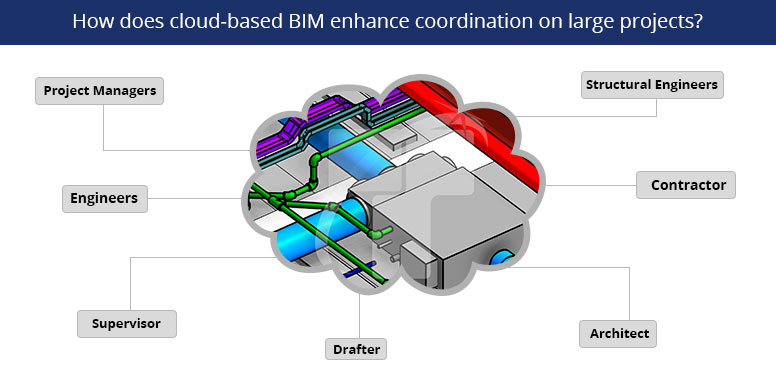How does cloud-based BIM enhance coordination on large projects?

Adoption of innovation in the construction industry has been moderate, yet the business is progressively getting to be mindful of BIM’s potential in this field. Use of BIM Services guarantees better decision making all through the lifecycle of a task. As BIM addresses age-old issues in a more financially savvy way with better critical thinking, increasingly compelling correspondence and quicker task assembling, a couple of BIM difficulties have been distinguished before usage can be the standard.
Table of Contents
BIM Services extraordinarily improves the consistency of building performance and its operations. It is gradually changing the design, building, and development scene with creative approaches to practice structure and oversee projects. As BIM use increments, so should coordinated effort inside task groups, which predicts improved gainfulness, diminished costs, better time management, and improved client customer connections. It has a clear potential financial advantage. The BIM achieves another worldview inside the AEC – the coordination of the jobs of all partners on a project may improve productivity and coordination yet may likewise display the danger of losing the significant check and balance mechanism in the current paradigm.
Construction information can be conveyed and reused among project directors and engineers at a place of work to ease issues on constructability and diminish the time and cost utilized. Utilizing the BIM innovation, project managers and specialists can pick up information identified with BIM and get feedback given by engineers on sight for future reference. This application of utilization of information sharing administration utilizing BIM innovation proposes a BIM-based Knowledge Sharing Management (BIMKSM) framework for project supervisors and designers. The usage of cloud-based BIM platform can enhance this information sharing and information management.
Cloud computing is currently playing an undeniably crucial role in encouraging BIM-based coordinated effort between the partners and various disciplines for complex AEC ventures. Autodesk’s Alliance for Revit is only one example of how BIM programming engineers are utilizing cloud computing to accelerate participation between colleagues, firms, and across various disciplines.
Construction and development industry includes a considerable number of partners who play different roles in carrying out their task from different scattered areas. This association of various partners, which is regular in the construction business has prompted fragmentation of the plan procedure. The impediments and complexities coming about because of this fragmentation can be overwhelmed by appropriate structure coordination by using Architectural BIM Services. The industry has moved from the two-dimensional plan process and grasped Building Information Models (BIM) that permits a data precious perception from the feasibility phase of undertaking empowering effective data to move among the partners.
Deploying the BIM on the ‘cloud’ stage or cloud computing can further upgrade the coordination, particularly clash detection. While BIM is undoubtedly an improvement contrasted with the paper-based structure process, no immediate component exists to catch the iterative trademark features of the procedure. Not many analysts have explored the utilization of structure component level forming utilizing object parameters that can store the plan data changes. A calculated system using the Industry Foundation Classes (IFC) that permits form and review history to be recovered at any example of time using a cloud-based BIM model server is proposed.
The fast development of BIM (Building Information Model) has changed the way AEC (Architecture, Engineering, and Construction) venture groups think and work in assembling their thoughts, prompt upgraded project delivering set apart by skilled data trade, mainly to tackle issues in clash detection. BIM is an information-rich, object-situated, advanced digital representation of facility, from where information and perspectives of the facility, by the designer’s specifications, can be removed and examined for necessary decision making.
The product is a membership subscription that supports and expands upon Revit, allowing it to store BIM models information in the cloud on a platform called BIM 360 Team. The center preferred position of cloud-based cooperation furnishes all colleagues with access to crucial models and tasks that are housed in a single place.
The clients prospective:
Clients can see Revit models that are a piece of a BIM 360 Team venture by using Revit by Manage Models instrument, allowing clients to make Revit models on the cloud, altering or adjusting them, regardless of where they happen to be arranged physically. Clients can work in a similar model simultaneously. Changes are synced to a focal model, usually when everybody’s work has been accommodated.
Clients can distribute the most recent variants of Revit models to the focal model in BIM 360 Team so that even colleagues who don’t utilize Revit can inspect or look through them. Another variant of a model is made each time a client synchronizes with the essential one, constructing a record of advancement that can be seen using the determination of past emphases.
Keeping that in mind, Autodesk Collaboration for Revit comes along with its online chat system called Communicator, so all the stakeholders getting cloud-based information can take part in quick correspondence with each other. Communicator shows up once Revit is opened and is accessible for use whether the application is opening, refreshing, sparing or syncing a model, and even once Revit has been shut.
On account of cloud availability, clients can get to BIM models and savvy object information utilizing the BIM 360 Glue application on their iPads, regardless of whether they’re in the workplace or out in the field.
This empowers partners to enhance the planning and coordination of their exercises, streamline their BIM work processes over the full cycle of project development from pre-development through development execution. This service assists the task survey process and encourages the goals of any coordination issues that may emerge throughout a complex, multidisciplinary undertaking.
The capacity to access composed BIM information in the field and on places of work has additionally extraordinarily improved the coordinated effort process for modelers, designers, and subcontractors. BIM 360 Glue is a piece of the BIM 360 development the executives bundle that Autodesk is advancing as a full suite of cloud-associated instruments that can be utilized whenever or area during the existence cycle of project development.
Conclusion:
Thus cloud-based BIM Services help all the participants working on a project to share information and collaborate during the life cycle of project development. Any changes made during the life cycle of a project is noted and acted upon by all the stakeholders. Looking onto this advantage of cloud-based BIM platform and its ease of information sharing, many countries are making it mandatory to use BIM for large public projects. BIM can thus be seen as practical and useful software for the smooth workflow and management of construction projects aiding the construction professionals to deliver successful projects with all the necessary information.

